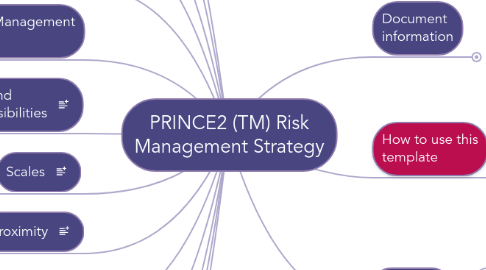
1. Sign-up FREE to edit this map
2. Tools and Techniques
2.1. [Refer to any risk management systems or tools to be used, and note any preference for techniques which may be used for each step in the risk management procedure]
3. How to use this template
3.1. How to share this template with your team
3.1.1. Send an email
3.1.1.1. 1. Click Share this map
3.1.1.2. 2. Select Invite People
3.1.1.3. 3. Write a message
3.1.1.4. 4. Click Invite
3.1.2. Send a link
3.1.2.1. 1. Click Share this map
3.1.2.2. 2. Tick Link to share
3.1.2.3. 3. Copy the link to share it
3.1.3. Export
3.1.3.1. 1. Click down arrow, bottom right
3.1.3.2. 2. Select the export option you want
3.2. How to complete this template
3.2.1. Complete the sections in square brackets
3.2.1.1. [....]
3.2.2. Read these sections for help on the template
3.2.2.1. Purpose
3.2.2.2. Advice
3.2.3. Navigate using the links in Contents
3.2.3.1. Contents
3.3. Attribution
3.3.1. Copyright © AXELOS Limited 2009. All rights reserved. Material is reproduced with the permission of AXELOS
3.4. Get this template here
4. Document information
4.1. Project Name
4.1.1. [name]
4.2. Date
4.2.1. [date]
4.3. Release
4.3.1. Draft/Final
4.4. Author
4.4.1. [author]
4.5. Owner
4.5.1. [owner]
4.6. Client
4.6.1. [client]
4.7. Document Number
4.7.1. [number]
4.8. Revision, Approvals & Distribution
4.8.1. Revision History
4.8.1.1. Revision # [....]
4.8.1.1.1. Revision Date
4.8.1.1.2. Previous Revision Date
4.8.1.1.3. Summary of Changes
4.8.1.1.4. Changes Marked
4.8.1.2. Revision # [....]
4.8.1.2.1. Revision Date
4.8.1.2.2. Previous Revision Date
4.8.1.2.3. Summary of Changes
4.8.1.2.4. Changes Marked
4.8.1.3. Revision # [....]
4.8.1.3.1. Revision Date
4.8.1.3.2. Previous Revision Date
4.8.1.3.3. Summary of Changes
4.8.1.3.4. Changes Marked
4.8.1.4. Date of next revision:
4.8.1.4.1. [....]
4.8.2. Approvals
4.8.2.1. Approval # [....]
4.8.2.1.1. Name
4.8.2.1.2. Signature
4.8.2.1.3. Title
4.8.2.1.4. Date of Issue
4.8.2.1.5. Version
4.8.2.2. Approval # [....]
4.8.2.2.1. Name
4.8.2.2.2. Signature
4.8.2.2.3. Title
4.8.2.2.4. Date of Issue
4.8.2.2.5. Version
4.8.2.3. Approval # [....]
4.8.2.3.1. Name
4.8.2.3.2. Signature
4.8.2.3.3. Title
4.8.2.3.4. Date of Issue
4.8.2.3.5. Version
4.8.3. Distribution
4.8.3.1. Distribution # [....]
4.8.3.1.1. Name
4.8.3.1.2. Title
4.8.3.1.3. Date of issue
4.8.3.1.4. Version
4.8.3.2. Distribution # [....]
4.8.3.2.1. Name
4.8.3.2.2. Title
4.8.3.2.3. Date of issue
4.8.3.2.4. Version
5. Overview
5.1. Purpose
5.1.1. A Risk Management Strategy describes the specific risk management techniques and standards to be applied and the responsibilities for achieving an effective risk management procedure.
5.2. Contents
5.2.1. The Risk Management Strategy should cover the following topics.
5.2.2. Introduction
5.2.3. Risk Management Procedure
5.2.4. Tools and Techniques
5.2.5. Records
5.2.6. Reporting
5.2.7. Timing of Risk Management Activities
5.2.8. Roles and Responsibilities
5.2.9. Scales
5.2.10. Proximity
5.2.11. Risk Categories
5.2.12. Risk Response Categories
5.2.13. Early-warning Indicators
5.2.14. Risk Tolerance
5.2.15. Risk Budget
5.3. Advice
5.3.1. The Risk Management Strategy is derived from the: Project Brief; Business Case; The corporate or programme management’s risk management guide, strategy or policy.
5.3.2. A Risk Management Strategy can take a number of formats, including: Stand-alone document or a section in the Project Initiation Document; Entry in a project management tool.
5.3.3. The following quality criteria should be observed:
5.3.3.1. Responsibilities are clear and understood by both customer and supplier
5.3.3.2. The risk management procedure is clearly documented and can be understood by all parties
5.3.3.3. Scales, expected value and proximity definitions are clear and unambiguous
5.3.3.4. The chosen scales are appropriate for the level of control required
5.3.3.5. Risk reporting requirements are fully defined.
